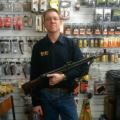Hi guys, new member here so first of all just thought I'd say Hi
Secondly, I just have a question regarding the makeup of roles and weapons in Infantry squads (specifically, the Army). From what I understand squads are made up of 2 or 3 "fireteams", of which each fireteam consists of:
- A Team Leader with an M16 or M4 rifle.
- A Grenadier with an M16 or M4 rifle with an M203 grenade launcher.
- An Automatic Rifleman with an M249 SAW.
- A Rifleman with an M16 or M4 rifle.
Assuming that's correct, I'm wondering where the other weapons and roles come in to the squad. For example:
- M240 machinegun
- M136 AT4
- M24 sniper rifle
- M16 SDM-R
I thought maybe in addition to the fireteams, the squad might have a "weapons team" or "specialist team" or something along those lines - basically a team that carries heavier and more specialised weapons (like the M240, M136 and SDM-R) to suppress and destroy hard targets.
Also, where do roles such as Snipers (or Advanced Marksmen), Squad Designated Marksmen and Medics come into the squad? Are they separate from the fireteams or do members of the fireteam also take on these roles in addition to their original assigned roles; in effect performing dual responsibilities?
Cheers guys.
















Bookmarks